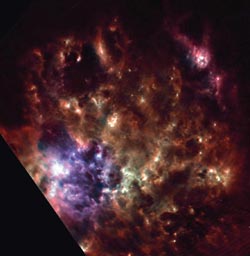AKARI’s view of Large Magellanic Cloud – star formation at work

This false-colour view of the Large Magellanic Cloud is a composite of images taken by AKARI at far-infrared wavelengths (60, 90 and 140 microns). The Large Magellanic Cloud is a neighbour galaxy to the Milky Way. Interstellar clouds in which new stars are forming are distributed over the entire galaxy. The bright region in the bottom-left is known as the 'Tarantula Nebula' and is a very productive factory of stars. This figure is a part of a data set covering a sky portion of about 17 000 by 17 000 light-years. Credits: JAXA
The Large Magellanic Cloud is a neighbouring galaxy to the Milky Way, the galaxy to which our Solar System belongs. It is located extremely close by astronomical standards, at a distance of 160 000 light years and it contains about 10 thousand million stars, about one tenth of our Galaxy's stellar population.
The first image is a far-infrared view obtained by the Far-Infrared Surveyor (FIS) instrument on board AKARI. It reveals the distribution of interstellar matter – dust and gas – over the entire galaxy. Dust grains in these interstellar clouds are heated by the light from newly born stars, and subsequently re-radiate this energy in the form of infrared light. So, the infrared emission indicates that many stars are currently being formed. Such copious star formation activity across a whole galaxy is called a 'star burst'.
The nature of the Large Magellanic Cloud is further revealed by the contrasting distribution of the interstellar matter and the stars. The interstellar matter forms a disk-like structure whilst the stars are located in the 'spindle' shape in the lower half of the image. This shows that the two components are clearly displaced from one another.
Astronomers believe that the observed star formation and the displacement of these two components in the Large Magellanic Cloud were both triggered by the gravitational force generated by our own Galaxy, the Milky Way.
The bright region in the bottom-left of the image is known as the 'Tarantula Nebula'. It is a very productive factory of stars.
The second image was taken at near- and mid-infrared wavelengths by AKARI's Infrared Camera (IRC), and provides a close-up view of part of the Large Magellanic Cloud.
This image shows many old stars (visible as white dots) in addition to the interstellar clouds. It enables astronomers to study the way stars recycle their constituent gases and return them to the interstellar medium at the end of their lives.
These and new data obtained by AKARI will unlock the secrets of how both the Large Magellanic Cloud and our own Galaxy have formed and evolved to their current state.
Media Contact
More Information:
http://www.esa.int/esaSC/SEMHP4PFHTE_index_0.htmlAll latest news from the category: Physics and Astronomy
This area deals with the fundamental laws and building blocks of nature and how they interact, the properties and the behavior of matter, and research into space and time and their structures.
innovations-report provides in-depth reports and articles on subjects such as astrophysics, laser technologies, nuclear, quantum, particle and solid-state physics, nanotechnologies, planetary research and findings (Mars, Venus) and developments related to the Hubble Telescope.
Newest articles

High-energy-density aqueous battery based on halogen multi-electron transfer
Traditional non-aqueous lithium-ion batteries have a high energy density, but their safety is compromised due to the flammable organic electrolytes they utilize. Aqueous batteries use water as the solvent for…

First-ever combined heart pump and pig kidney transplant
…gives new hope to patient with terminal illness. Surgeons at NYU Langone Health performed the first-ever combined mechanical heart pump and gene-edited pig kidney transplant surgery in a 54-year-old woman…

Biophysics: Testing how well biomarkers work
LMU researchers have developed a method to determine how reliably target proteins can be labeled using super-resolution fluorescence microscopy. Modern microscopy techniques make it possible to examine the inner workings…





















